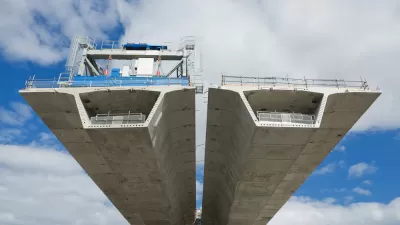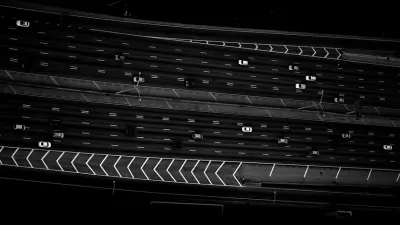Giving new meaning to the phrase "take back the streets," Neal Peirce writes about the arguments in favor of a "freeway free" future for the world's cities, which was the subject of a recent Rockefeller Foundation Conference held in Bellagio, Italy.
There has been a lot of buzz around freeway removals lately, as more and more cities begin to contemplate more efficient land uses. Peirce states that although freeways were designed to alleviate traffic congestion on streets, they instead "encourage more auto use and end up triggering some of the most massive traffic snarls known to humanity." Furthermore, "freeway-free" advocates such as former Bogota Mayor Enrique Peñalosa, point out that "limited-access superroads, with extraordinarily high construction costs, soak up public revenue that could go into schools, housing, libraries and public health to improve the lives of millions of families scraping by at subsistence levels."
Instead of depending on these massive pieces of infrastructure, Peirce says, planners should rethink how streets and automobiles are used, and look to cities like Milwaukee, San Francisco and Seoul, who have done away with major freeways, for inspiration.
Another "freeway-free" theorist, architect and planner Peter Calthorpe, suggests "that freeway-free cities could be planned with a broad network of car-less avenues, each offering generous space for walking, biking and exclusive bus lanes, an environment perfect for apartments and shops. Each such avenue would be separated a few hundred yards in each direction from parallel one-way streets that accommodate cars and trucks."
A major benefit of this "freeway-free" vision of a city, as U.N.-Habitat Director Joan Clos claims, is the adoption of more sustainable and efficient development that will deter sprawl while accommodating expanding populations in major world cities.
FULL STORY: A ‘Freeway-Free’ Future for World Cities?

Alabama: Trump Terminates Settlements for Black Communities Harmed By Raw Sewage
Trump deemed the landmark civil rights agreement “illegal DEI and environmental justice policy.”

Planetizen Federal Action Tracker
A weekly monitor of how Trump’s orders and actions are impacting planners and planning in America.

Why Should We Subsidize Public Transportation?
Many public transit agencies face financial stress due to rising costs, declining fare revenue, and declining subsidies. Transit advocates must provide a strong business case for increasing public transit funding.

How Housing as a Financial Product Harms Communities
Institutional buyers who treat housing as an investment product become disconnected from the impacts of higher rents, displacement, and housing instability.

Blinded by the Light: When Brighter Headlights Decrease Safety
Bright LED headlights can create glare and reduce visibility for other drivers and pedestrians.

Study Links Covid and Poor Driving
The effects of the virus, including ‘brain fog,’ can make driving more difficult and dangerous.
Urban Design for Planners 1: Software Tools
This six-course series explores essential urban design concepts using open source software and equips planners with the tools they need to participate fully in the urban design process.
Planning for Universal Design
Learn the tools for implementing Universal Design in planning regulations.
Caltrans
Smith Gee Studio
Institute for Housing and Urban Development Studies (IHS)
City of Grandview
Harvard GSD Executive Education
Toledo-Lucas County Plan Commissions
Salt Lake City
NYU Wagner Graduate School of Public Service




























